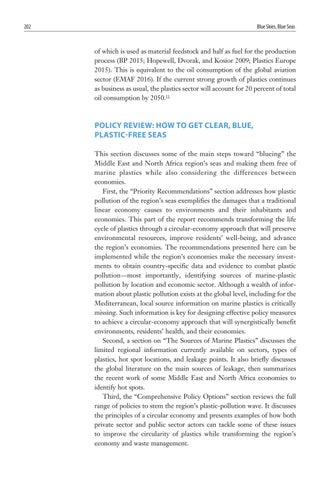202
Blue Skies, Blue Seas
of which is used as material feedstock and half as fuel for the production process (BP 2015; Hopewell, Dvorak, and Kosior 2009; Plastics Europe 2015). This is equivalent to the oil consumption of the global aviation sector (EMAF 2016). If the current strong growth of plastics continues as business as usual, the plastics sector will account for 20 percent of total oil consumption by 2050.11
POLICY REVIEW: HOW TO GET CLEAR, BLUE, PLASTIC-FREE SEAS This section discusses some of the main steps toward “blueing” the Middle East and North Africa region’s seas and making them free of marine plastics while also considering the differences between economies. First, the “Priority Recommendations” section addresses how plastic pollution of the region’s seas exemplifies the damages that a traditional linear economy causes to environments and their inhabitants and economies. This part of the report recommends transforming the life cycle of plastics through a circular-economy approach that will preserve environmental resources, improve residents’ well-being, and advance the region’s economies. The recommendations presented here can be implemented while the region’s economies make the necessary investments to obtain country-specific data and evidence to combat plastic pollution—most importantly, identifying sources of marine-plastic pollution by location and economic sector. Although a wealth of information about plastic pollution exists at the global level, including for the Mediterranean, local source information on marine plastics is critically missing. Such information is key for designing effective policy measures to achieve a circular-economy approach that will synergistically benefit environments, residents’ health, and their economies. Second, a section on “The Sources of Marine Plastics” discusses the limited regional information currently available on sectors, types of plastics, hot spot locations, and leakage points. It also briefly discusses the global literature on the main sources of leakage, then summarizes the recent work of some Middle East and North Africa economies to identify hot spots. Third, the “Comprehensive Policy Options” section reviews the full range of policies to stem the region’s plastic-pollution wave. It discusses the principles of a circular economy and presents examples of how both private sector and public sector actors can tackle some of these issues to improve the circularity of plastics while transforming the region’s economy and waste management.






